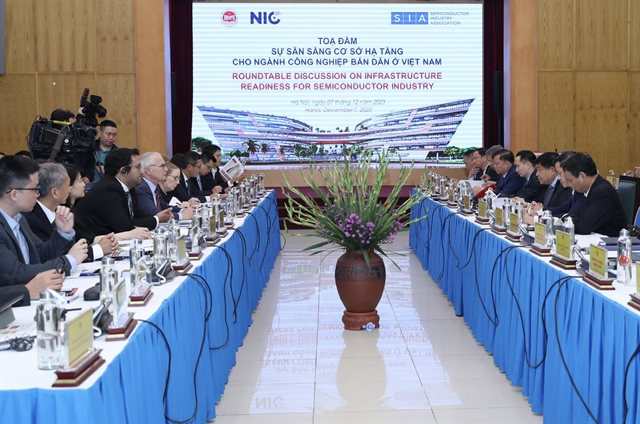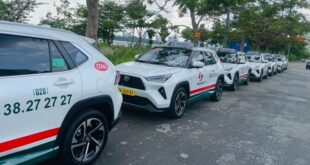
|
| The roundtable discussion on infrastructure readiness for semiconductor industry in Việt Nam. Photo courtesy of NIC |
HÀ NỘI Việt Nam is ready in terms of infrastructure and necessary conditions to receive investment projects from US semiconductor enterprises, said Minister of Planning and Investment Nguyễn Chí Dũng.
The Ministry of Planning and Investment (MPI) and the National Innovation Centre (NIC) in co-ordination with the the US’s Semiconductor Industry Association (SIA) organised a roundtable discussion on infrastructure readiness for the semiconductor industry in Việt Nam in Hà Nội on Thursday.
Speaking at the discussion, Minister Dũng said that in order to implement the content of cooperation in developing the semiconductor industry in the Việt Nam – US joint statement, Việt Nam has prepared conditions to be ready to receive and cooperate with US businesses and investors in the semiconductor industry supply chain.
The country has perfected the one-stop mechanism, developed a project to develop human resources for the semiconductor industry to reach 30,000 people by 2030, and established NIC Hòa Lạc to host investment projects in the semiconductor industry with the highest incentives.
“Today’s discussion focuses on discussing infrastructure readiness for the semiconductor industry in Việt Nam. I believe that SIA and its member businesses will receive a lot of information to soon have plans to co-operate and invest in Việt Nam,” emphasised Dũng.
John Neuffer, head of SIA, shared about the US – Việt Nam cooperation activities to promote the semiconductor industry.
Neuffer pointed out that SIA’s member businesses, many of which are present at the event, have significant investments in Việt Nam, including Intel, Marvell, Synopsys, Qualcomm, Ampere, and Infineon.
“Many businesses are doubling their investments… These investments are a testament to Việt Nam’s pivotal and growing role in the global semiconductor supply chain. We see incredible opportunities for Việt Nam to grow its footprint in global semiconductor supply chains,” said Neuffer.
Việt Nam has had quite specific and consistent orientations, goals and actions to build important initial foundations for the semiconductor industry and is currently considered a country with a dynamic innovative ecosystem thanks to the rapid development of the digital economy and the strong growth of the high-tech sector.
Việt Nam is increasingly asserting itself as the new economic growth centre of Asia with a solid position in the global supply chain, continuously receiving investment from multinational corporations.
Marvell Việt Nam representative said that during the past 10 years, the company has had a very clear commitment to develop human resources in the next three to five years through cooperation with universities and research institutes along with the support of the Vietnamese Government.
Protecting creative intelligence was extremely important for companies to invest in Việt Nam, he said.
The company expected to be able to cooperate with member companies and ministries here to develop Việt Nam’s semiconductor industry, he added.
Vương Quốc Tuấn, Standing Vice Chairman of Bắc Ninh province’s People’s Committee, shared that the province saw this was an opportunity to grasp and prepare for receiving capital from abroad.
In the field of semiconductors, in terms of infrastructure, Bắc Ninh industrial park is the area with the largest industrial infrastructure in the North to become a centre for innovative research and transfer.
It has a policy of supporting 50 per cent of tuition fees for students in the high-tech field.
Deputy Minister of Education and Training Nguyễn Văn Phúc said that Việt Nam had strengths in training mathematics and chemistry, leading in Southeast Asia, thus creating a good foundation for industries such as semiconductors and information technology.
“Currently, about 200,000 Vietnamese students are studying abroad. So, if Việt Nam develops high-tech industries, Việt Nam has about 40 universities providing training in fields related to semiconductors. If demand for the semiconductor chip industry increases, students will become more interested in this field and Việt Nam can fully meet the human resources needs from additional training to completely new training,” said Phúc.
“We really want US businesses to cooperate closely with universities, build training programmes, support students for internships, and support universities to build laboratories,” he said.
Nguyễn Anh Thi, Head of HCM City Industrial Park Management Board, said that for the semiconductor chip industry, the city had a relatively seamless ecosystem, possessing highly qualified human resources and a culture of innovation.
HCM City recognised the importance of human resources from the beginning of last year. It has a semiconductor training centre with Synosys to promote human resource training in Việt Nam and HCM City in particular.
At the seminar, SIA member businesses, and Vietnamese localities and businesses discussed ways of cooperation on infrastructure conditions to meet the requirements of semiconductor industry businesses.
The MPI, the Ministry of Information and Communications, the Ministry of Industry and Trade, Vietnamese localities and businesses have also provided SIA and its member businesses with basic information about the business investment environment and electricity, water, transportation infrastructure conditions and preferential policies in industrial parks, economic zones, and high-tech zones. VNS
- Reduce Hair Loss with PURA D’OR Gold Label Shampoo
- Castor Oil Has Made a “Huge” Difference With Hair and Brow Growth
- Excessive hair loss in men: Signs of illness that cannot be subjective
- Dịch Vụ SEO Website ở Los Angeles, CA: đưa trang web doanh nghiệp bạn lên top Google
- Nails Salon Sierra Madre
 VnExpress News The News Gateway of Vietnam
VnExpress News The News Gateway of Vietnam





